Top News
December 25, 2011 Ryukyu Shimpo
The Ministry of Defense announced on December 24 that it has allocated around one billion yen from the annual budget for fiscal 2012 for site acquisition to deploy a coastal monitoring team of the Japan Ground Self-Defense Force on Yonaguni Island.
Considering the fact that the U.S. Senate and the House of Representatives agreed to cut funding for the planned relocation of the U.S. Marines from Okinawa to Guam, which is supposed to happen in tandem with the moving of Futenma Air Station within the prefecture, the Ministry allocated about 8.1 billion yen to funding for the relocation of the Okinawa-based Marines to Guam for fiscal 2012, a reduction of about 80% from the figure for this fiscal year.
With regard to costs related to the relocation of Futenma Air Station, the Ministry did not allocate construction costs for the Futenma Replacement Facility to cover the relocation of the base to Henoko in the Nago district, but, as it did this fiscal year, the Ministry did allocate about 2.2 billion yen for land construction costs in Camp Schwab and about 1.5 billion yen to costs for the current environmental impact surveys.
The Ministry allocated 93.2 billion yen to rent for land occupied by the U.S. military facilities in Okinawa, up 1.64% from the previous fiscal year.
(English translation by T&CT, Mark Ealey)
Go To Japanese

December 21, 2011 Ryukyu Shimpo
On December 19, Misato High School broadcasting club completed a documentary film entitled Koza ga moeta hi (The day Koza burned), which was produced to commemorate the 40th anniversary last year of the Koza Riot. Additional interviews and some revisions were included in the final version. The film contains not only testimony from those involved, but also covers residents’ efforts to establishment the background to the event and comments from military police who faced off against the angry crowd. Chatan Town, where economic development has been achieved after land used by a U.S. base was returned, appears on the film in order to appeal to people break away from dependence on a base-related economy. The film covers the various dimensions of the issue of the U.S. military presence in Okinawa.
The documentary received an incentive award in the NHK Inter High School Broadcasting Contest in July.
Second grade students Akane Ashitomi and Yuumi Yagi of the Misato High School broadcasting club commented that they were impressed that Okinawan people did nothing towards African-Americans, who were discriminated in the United States, and that women also participated in the riot.
“I think it was discrimination that Okinawan people fought against in the Koza Riot,” said third grade student Sato Yamakawa.
Second grade student Rena Maekado said, “Even today when incidents involving U.S. military personnel occur, Okinawan people have to clamor for them to be handled properly, so the situation now is basically unchanged.”
(English translation by T&CT, Shinako Oyakawa and Mark Ealey)
Go To Japanese
December 21, 2011 Ryukyu Shimpo
In the 2010 fiscal year the number of annual passengers on civilian aircraft using Naha Airport was calculated to be 14225909, putting it in the top five of the approximately 90 airports in the country. While the airport ranked seventh in the 2008 fiscal year, it edged out Kansai International Airport in the 2009 fiscal year and Osaka International Airport (Itami) in the 2010 fiscal year. The top four were Haneda, Narita, New Chitose and Fukuoka.
Regarding coming fifth, Moritake Tomikawa, the president of Okinawa International University said that from the point of view of tourism “moving up the list was very pleasing.” But at the same time, he pointed out the problem of the overcrowding at Naha Airport, saying that, “In order to become a hub airport in Asia much needs to be done to improve the airport. The existing approach is insufficient to increasing demand into the future. We need to expand the airport as soon as we can.”
Because Naha Airport is shared with the Japan Self-Defence Forces, there are many issues such as overcrowding on runways and a congested international terminal building. Furthermore, new foreign airline companies and low-cost carriers will commence flights to Okinawa the year after next, and so tourism industry officials have been advocating the necessity of promptly improving the airport facilities.
The government plans to expand the runways of Naha Airport, but the date to start construction is yet to be determined. By the end of 2013 fiscal year, the Naha Airport Building (NABCO) intends to add an international building with four stories above ground, which represents an extra 20000 square meters of floor space. But even so, a tourism industry official suggests that the current NABCO plan is insufficient for the airport to compete with other Asian tourist spots.
On December 19, a F-15 fighter of JSDF deviated from the runway. The airport closed temporarily as a result to deal with the accident and many tourists were inconvenienced. On the same day, President of the Okinawa Convention & Visitors Bureau Shigenobu Asato held an emergency meeting and said, “The airport is too crowded. When it is decided to expand the runways, we need to discuss the way in which Naha Airport is used for joint military-civilian purposes.”
(English translation by T&CT, Lima Tokumori and Mark Ealey)
Go To Japanese
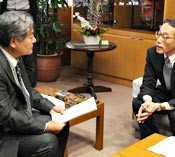
December 21, 2011 Ryukyu Shimpo
On December 20, the Ministry of Defense responded to questions posed by the Okinawa Prefectural Government (OPG) with regard to “The role and importance of the United States Forces in Japan including the Marines Corps.” The Defense Ministry booklet with this title gives reasons for stationing the U.S. Marines Corps in Okinawa, and also provides answers to questions about the MV-22 Osprey vertical take-off and landing transport aircraft that is scheduled to be deployed at Futenma from summer 2012.
However, the Ministry provided no clear answers regarding the validity of the claim made by the governments of both countries that the stationing of the Marines in Okinawa serves as a deterrent in the Asia Pacific region. With regard to the Osprey, the Ministry reported that the noise from this aircraft during hovering, take-off and landing is greater than that generated by aircraft currently deployed, and that in the past, high-temperature exhaust gas emission has caused fires to break out on the Osprey aircraft.
Okinawa Defense Director Ro Manabe visited Okinawan Vice Governor Kanetoshi Yoseda on December 20 to hand over the written response to questions posed. The Ministry is responding to questions from the OPG about the Osprey aircraft for the second time.
With regard to “The role and importance of the United States Forces in Japan including the Marines Corps,” the Ministry pointed out that if the Marines are relocated to Kyushu or the main islands of Japan, the greater distance involved means that they would not have sufficient time to respond in the event of an emergency situation in the Taiwan Straits or South-East Asia. However, the Ministry did not give any details of the role that the Marines would assume in situations envisioned, nor did it provide any basis for their stationing in Okinawa as a deterrent in the region. With regard to the situation surrounding North Korea, which is expected to become increasingly unstable, the Ministry did state that in the event of an emergency there, the Marines would be at an advantage in terms of deployment if they were stationed in Kyushu or the main islands of Japan, which are closer to Korean Peninsula.
The Ministry reported that Omura Airport (Japan Maritime Self-Defense Force Omura Air Base in Nagasaki Prefecture), Saga Airport and Guam, Tinian Island and Tokunoshima were considered by the Hatoyama administration for the relocation of Futenma Air Station. However, the Ministry did not give a clear reason for not relocating the base and its personnel to any of these locations. It reported that in addition to the option of relocating the base to Henoko in the Nago district, the central government also considered relocation to a land-based section of Camp Schwab or integrating the functions of Futenma with those of Kadena Air Base.
At the same time, the Ministry offered only a general conclusion with regard to the central government returning to the plan of relocating Futenma Air Station to Henoko, saying that “Okinawa offers logistical advantages over other prefectures.”
Among the various U.S. Army, Navy, Air Force and Marine units deployed in Okinawa, the Ministry emphasized the importance of the Marines, saying, “Only the Marines have ground forces.” Although the Ministry pointed out that the Marines play a vital role in exercising deterrence in the regions, it did not clearly state how important the Marines are in terms of achieving such “deterrence.”
(English translation by T&CT, Mark Ealey)
Go To Japanese

Go To Video
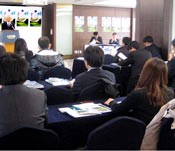
December 21, 2011 Ryukyu Shimpo
On December 15, a presentation on the Korea-Okinawa Friendship Junior Golf Camp in Okinawa, which was selected by the Okinawa-ken Government from among submissions from the public as a project for sport tourism, was held at a hotel in Seoul. It is hoped that through this camp, people will understand that Okinawa is warm even in winter and is well suited to golf-camps, and also that the level of junior players will improve through such exchanges.
The camp is a 2011 Sports Tourism Strategic Promotion project aiming to attract tourists to Okinawa through sport and it is organized by the Okinawa-ken Golf Association and the Ryukyu Shimpo.
Yoshio Higa, the head of the Okinawa-ken Golf Association, golf teaching professional Masaru Miyazato, who is an adviser for the camp and Satoshi Ikema, director of the project division of the Ryukyu Shimpo attended at the presentation meeting. They talked about Okinawa from the point of view of the camp, the circumstances for golf in the prefecture, and the weather conditions in winter. A total of 36 companies involved in newspapers or magazines covering travel, tourism and the golf industry participated.
Higa explained that they have been concentrating on the development of junior golfers saying, “I hope that the young people and children of Okinawa will improve their skills through exchange with their Korean counterparts.”
Talking about his experience raising his daughter, professional golfer Ai Miyazato, Masaru Miyazato said, “Experience of competitions in the international arena builds mental toughness. I firmly believe that the camp will very beneficial for the youth of Okinawa and Korea.”
There were questions from the floor regarding the importance of allocating prefectural budget for the camp and some advice was forthcoming on how to run the camp smoothly.
By December 16, Higa and others had visited the Korea Elementary School Golf Association, the Korea Junior and Senior High School Golf Association, and explained the reasoning behind the camp then requested that Korea consider sending players. Both Associations adopted a positive stance on these suggestions.
(English translation by T&CT, Lima Tokumori and Mark Ealey)
Go To Japanese
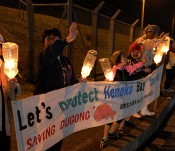
On Christmas Eve, a Peace Candle service was held in front of the No. 1 gate of Camp Schwab at Henoko in Nago. The service has been held there every Saturday evening by residents who wish to preserve the sea of Henoko and to persuade the government to cancel plans to construct the replacement facility for the U.S. Marine Corps Air Station Futenma in this location. This last service of 2011 was carried out in the context of the government being about to submit the Environmental Impact Report as part of the process to carry the plan forward. Ten people, including the group’s 56 year-old leader Takekiyo Toguchi and members of his family, held candles as the light of peace, as they prayed for a successful end to their opposition to the Henoko base construction.
This Peace Candle service was first held in November 2004, and has now entered its eighth year. In June, at the Japan-U.S. Security Consultative Committee, the governments of Japan and the United States decided upon the construction plan which includes a V-shaped runway at Henoko. The government canceled its search for a place outside Okinawa for the replacement facility and reconfirmed its intention to build it at Henoko. Toguchi questioned the government’s taking a hard stance on the submission of the Environmental Impact Report, saying, “Do they really think they can build here? Are they prepared to go against the opposition of the Governor of Okinawa and the Mayor of Nago to push the plan forward?”
The Peace Candle service began at 6:30pm on Saturday with the participants holding candles placed inside plastic bottles. They appealed to American soldiers and other people driving past the National Highway No. 329 in front of the gate of the base, gently waving their hands as they held a banner written in English and Japanese saying “Save the sea of Henoko.” Toguchi said, “Seven years have passed since we began these Peace Candle services, which indicates how Henoko has been an ongoing issue for a long time. I really hope that there will be a good outcome next year.” He will continue these Peace Candle services next year.
(English translation by T&CT, Mark Ealey)
Go To Japanese
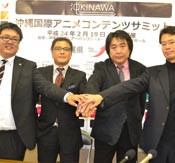
December 16, 2011 Ryukyu Shimpo
On February 19 next year, the Okinawa International Animation Contents Summit, featuring attractions of animation and content, and including events such as a world-class museum of Japanese animation contents, a panel exhibition of the Ultraman Series, live performances by national top-class voice actors of animation songs, exhibitions of Okinawan animation content and a symposium will be held in Naha. On December 15, the Naha-based company Kariyushi, which is organizing the summit, presented a business summary at the prefectural office. Director Satoshi Toyama said, “This event will attract attention not just within Japan, but also overseas. On the day, I really want to make Naha glow with animation content.”
The project was adopted by the Okinawa Prefectural Government to help support the development of tourism. There will be exhibitions and screenings of the Okinawan Animation Contents Museum, the Okinawan Animation Contents Theater and live performances of the Okinawan Animation Contents Songs. In addition, the Ultraman Series that marks its 45th anniversary, Ryujin Mabuyer which is an animation made in Okinawa, and Shimanchu! Mirika also will feature.
At the museum there will be a panel exhibition with Tetsuo Kinjo, a scriptwriter of Ultraman.
High profile guests will be Rika Matsumoto who sings the extremely popular animation Pocket Monster’s theme song and plays its leading character, Yoko Takahashi, who sings the theme songs of the animation Neon Genesis Evangelion both in the theatrical version and the television version, Aya Hirano, who plays the main character and takes charge of theme songs of an animation called Melancholy of Haruhi Suzumiya, Azumi Inoue who sings the theme songs of the animation My Neighbor Totoro, PSYCHIC LOVER which is a group that sings the opening theme of Samurai-sentai Shinkenger on television. This spectacular line-up of guests will perform live with the global environment as the theme.
The project seeks to attract tourists from other prefectures within Japan and from the countries of East Asia, aiming to become a major base for animation contents and to disseminate such contents from Okinawa. This time, including 200 peoples on official tours, around 2200 visitors are expected to come from within Okinawa and from other prefectures, and from the second year the number is expected to expand to 5000 as the number of visitors from China, Taiwan and South Korea increases.
In addition to Kariyushi, Noboru Nakajima of Naledge Kids (Naha) will work as a producer and Junichi Hasegawa of the Naha Branch of the Human Academy Company will organize the live shows. Tsuburaya Productions will also cooperate in the organization of the events.
From December 15, tickets for the museum and the live performances will be on sale at Lawson Ticket.
For further information contact Kariyushi. Telephone: 098 (861) 7799.
(English translation by T&CT, Lima Tokumori and Mark Ealey)
Go To Japanese
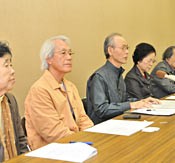
December 20, 2011
On December 19, prominent Okinawan intellectuals held a press conference to publically agree with the statement accepted unanimously by the prefectural assembly in November on “Opposition to the relocation of Futenma Air Station to Henoko, and to submit a statement asking for the abandonment of the Henoko evaluation report.” A total of 19 people were involved including university professors and representatives of citizens’ groups. Former governors Keiichi Inamine and Masahide Ota have also joined the group, which further suggests that there is a consensus of opinion in the prefecture that transcends politics.
The intellectuals issued the message without delay since the government plans to submit the Henoko environmental impact report before the end of this year.
In the message, they agreed with the assembly’s statement representing the will of the people of Okinawa. They also emphasize, “Asking for the closure and return of the Futenma Air Station and opposing the relocation plan within Okinawa now represents the collective opinion of the people.”
Moriteru Arasaki, one of the people involved and a professor emeritus of Okinawa University said, “The Constitution stipulates that the will of the local people should be given consideration when an important decision is to be made about a matter in that region.” He also criticized the government’s response moving ahead on the agreement, which the Okinawa prefecture strongly objects, saying, “Despite the statement of the prefectural assembly being a declaration representing the intent of the local people, it is being completely ignored by the government.”
(English translation by T&CT, Shinako Oyakawa and Mark Ealey)
Go To Japanese
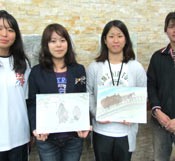
December 19, 2011 Ryukyu Shimpo
Students with no experience of war are passing on stories of the Battle of Okinawa and speaking to members of the next generation about the meaning of peace. The group is called Kataritsugibe, and is make up of student volunteers from the University of the Ryukyus. They said, “We want to convey the spirit of the people who survived the war to go on to establish our current society with tragic stories of war in their past. Also, people need to realize that the circumstances in which we find ourselves are not the way it should be.” They plan to speak at elementary schools and junior high schools.
The group’s activities commenced with 39 pictures painted by Seiji Hiranaka, the grandfather of Airi Hiranaka, a sophomore of the Facility of Education. In August, in preparation for using these pictures to tell others about the nature of war and the meaning of peace, Airi and four of her friends began interviewing Seiji and others who had experienced the war. On December 17, in an event called Heiwa no Yube, organized by Okinawa Teachers Union Education Institute at Education Welfare Hall in Naha, they performed the play The Battle of Okinawa in which grandchildren pass on the grandparents’ wartime experiences.
Airi originally intended to use several pictures of scenes from the battle because she was brought up having heard about her grandfather’s war experiences, but listening to what he had to say, she began to think about the meaning of pictures of pre-war scenes in Okinawa. She said, “When my grandfather talked so fondly about his life before the war, I realized that he had been robbed of some precious aspects of his life.” With this, she began to think that she should convey not just the damage caused by war, but also things have been lost, and the thinking of the people involved in the reconstruction.
The students met many times to discuss the weighty issue of the Battle of Okinawa. Erika Yamashiro said, “Everyone had some form of war experience to relate. I now have a broader view of Okinawa.” Shiori Tamashiro who wrote the various scenes for the drama said, “I have become able to get a grasp on where I have come from.”
Airi, one of key members of the group said, “While we cannot talk about the war with the same feeling as people who actually went through it, I do believe that we are able to inherit the strength that allowed them to survive and maintain the things that are precious to us all.”
(English translation by T&CT, Lima Tokumori and Mark Ealey)
Go To Japanese
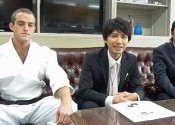
December 17, 2011 Ryukyu Shimpo
On December 16 at the Prefectural Government Offices, representatives of Yomitan Kururu Resort Okinawa, which manages the Taiken Okoku Murasaki Mura in Yomitan, met with executives from four other firms and announced that they will commence a model project to promote tourism by building a brand that utilizes Okinawa’s traditional karate. From March 2012, based in Murasaki Mura, they will commence three projects including a company orientation program with karate, karate trial lessons, and a karate show in conjunction with Ryukyuan dance.
This is a prefectural 2011 industry collaboration model project and the total cost is 35 million yen. Thirteen employees have been newly hired for the project.
At Murasaki Mura, about 1000 people each year, mostly students on school excursions, experience the existing karate trial course. Collaborating with tour companies, Murasaki Mura wants to attract company trips and to increase the use of company orientation programs that use karate. On December 21, there will be a trial company orientation.
The story-telling karate show, which is based on aspects of the history of Okinawa including the Satsuma invasion and the Battle of Okinawa, is produced by a Ryukyuan Performing Arts producer, Michihiko Kakazu. Jungo Matsuda karate shihan master from the World Oshu-kai Kobayashi-ryu Kobudo Renmei, who instructs karate for the show said, “The show embraces the history and culture of Okinawa. There is a philosophy of accepting rather than defeating an opponent. I would like to promote this good philosophy of life more to Okinawans, Japanese and people overseas.
Toru Iketani, division director from Roots, which is in charge of the company orientation program using karate, stated, “The spirituality of traditional karate can be utilized in business. We would like companies from other prefectures to come to Okinawa for their orientation programs and hopefully help promote those industries locally. Companies in Okinawa may also use the program.”
Tamotsu Ganaha, director from Vision Project that handled the model project, said, “Although there is a difficult aspect to connecting tradition with business, using the karate show as the main source of revenue and appealing to tourists with the orientation programs, we would like to draw attention to tourism and eventually even attract people from overseas.”
(English translation by T&CT, Megumi Chibana and Mark Ealey)
Go To Japanese
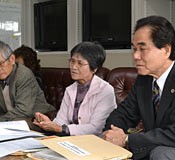
December 15, 2011 Ryukyu Shimpo
On December 14 at the prefectural government offices, a war victim group filing a collective lawsuit with the central government for an apology and compensation to civilian casualties in the Battle of Okinawa, made its stance clear on a war victim assistance bill. On December 8, a multi-party group of Diet members announced a war victim special assistance bill for the Battle of Okinawa victims and an assistance bill for victims of air-raids. Commenting that both bills have “revolutionary content,” the war victim group pledged to do its best to see the bills enacted.
With regard to the war victim special assistance bill for victims of the Battle of Okinawa, lead attorney Shigeru Zukeyama of the War Victim Group said, “It would make civilian victims eligible for compensation regardless of whether or not they were engaged in the fighting. To have the bills enacted, we would like to make this a prefecture-wide movement.”
Through the lawsuit, the group is planning to appeal to the public regarding the enactment of the bills, which will be submitted to the ordinary session of the Diet in February 2012. To promulgate the bills in the prefecture, the group is seeking cooperation from the Yaeyama Wartime Malaria Bereaved Families Group and the Wartime Sunken Ships Bereaved Families Group.
Inquiries should be directed to the Zukeyama Law Firm at 098 (833) 7447. On December 15 from 10:00am to 5:00pm a briefing session on the lawsuit will be held at the law firm and a free consultation service is offered at all times.
(English translation by T&CT, Megumi Chibana and Mark Ealey)
Go To Japanese










 Webcam(Kokusai Street)
Webcam(Kokusai Street)


